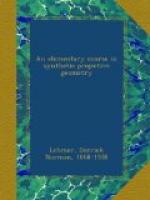179. Descriptive geometry and the second revival. The second revival of pure geometry was again to take place at a time of great intellectual activity. The period at the close of the eighteenth and the beginning of the nineteenth century is adorned with a glorious list of mighty names, among which are Gauss, Lagrange, Legendre, Laplace, Monge, Carnot, Poncelet, Cauchy, Fourier, Steiner, Von Staudt, Moebius, Abel, and many others. The renaissance may be said to date from the invention by Monge(17) of the theory of descriptive geometry. Descriptive geometry is concerned with the representation of figures in space of three dimensions by means of space of two dimensions. The method commonly used consists in projecting the space figure on two planes (a vertical and a horizontal plane being most convenient), the projections being made most simply for metrical purposes from infinity in directions perpendicular to the two planes of projection. These two planes are then made to coincide by revolving the horizontal into the vertical about their common line. Such is the method of descriptive geometry which in the hands of Monge acquired wonderful generality and elegance. Problems concerning fortifications were worked so quickly by this method that the commandant at the military school at Mezieres, where Monge was a draftsman and pupil, viewed the results with distrust. Monge afterward became professor of mathematics at Mezieres and gathered around him a group of students destined to have a share in the advancement of pure geometry. Among these were Hachette, Brianchon, Dupin, Chasles, Poncelet, and many others.
180. Duality, homology, continuity, contingent relations. Analytic geometry had left little to do in the way of discovery of new material, and the mathematical world was ready for the construction of the edifice. The activities of the group of men that followed Monge were directed toward this end, and we now begin to hear of the great unifying notions of duality, homology, continuity, contingent relations, and the like. The devotees of pure geometry were beginning to feel the need of a basis for their science which should be at once as general and as rigorous as that of the analysts. Their dream was the building up of a system of geometry which should be independent of analysis. Monge, and after him Poncelet, spent much thought on the so-called “principle of continuity,” afterwards discussed by Chasles under the name of the “principle of contingent relations.” To get a clear idea of this principle, consider a theorem in geometry in the proof of which certain auxiliary elements are employed. These elements do not appear in the statement of the theorem, and the theorem might possibly be proved without them. In drawing the figure for the proof of the theorem, however, some of these elements may not appear, or, as the analyst would say, they become imaginary. “No matter,” says the principle of contingent relations, “the theorem is true, and the proof is valid whether the elements used in the proof are real or imaginary.”




